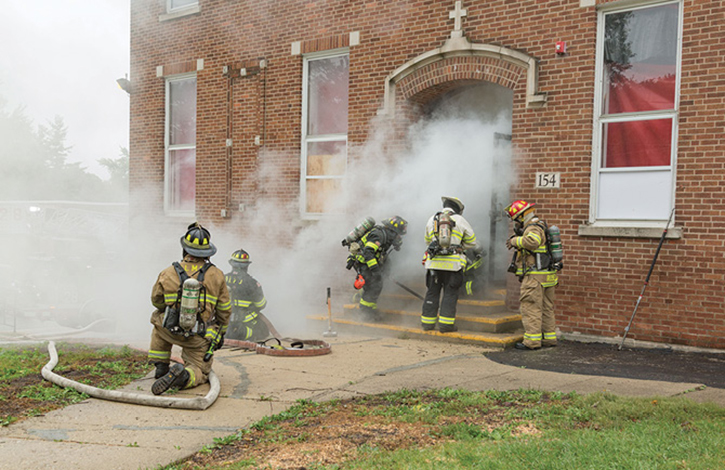
Across the country, in today’s fast-paced world of emergency response systems, we as a community have evolved. But, this evolution of response systems does not equally affect our community wholly, which can cause problems when trying to coordinate response and mutual-aid efforts. In some areas of the country, the morphing of response systems is quite progressive, making every incident more likely to be mitigated rapidly by ensuring coverage areas are always protected and the quickest and most effective response (based on testing and research) is achieved. In other areas, consistency is lacking, and resources are not supported or depended on, both in local agencies and those that they border. Even worse, some of the most progressive departments in the country fail to recognize supporting agencies based on personal bias and preference, further delaying resource arrival to a situation that is degrading extremely fast.
Regional Multicompany Hands-On Training
The Mutual-Aid Box Alarm System
Regional RIT: the Suburban Response to Rapid Intervention
If you are reading this article, you know that houses, buildings, furniture, cars, and pretty much anything that catches on fire today will burn much more quickly than in years prior. With new materials introduced, houses will collapse, trapping victims who would have been able to escape and destroying property that may have been safe for much longer just a few years ago. With this in mind, how can we continue to be complacent with the manner in which we assign and dispatch resources to incidents?
Same Fire, Different Areas
For example, let’s say a busy day is about to unfold in two very different areas of the country. Crews are arriving for their shift, checking out their vehicles, checking equipment, and catching up. While this is occurring, fires started at the same time with the same points of origin and even the same house design, layout, and features. What a coincidence! The residents are still asleep upstairs. It’s a Saturday morning around 8:30 a.m. In both situations, a passerby notices smoke beginning to escape from the cracked first-floor window and reports this to the 911 center. Here’s where things start to change for each fire’s evolution and outcome.
First Fire
The first 911 center receives the call. Immediately, through computer-aided dispatch (CAD) software, appropriate questions are asked, identifying a possible structure fire. The CAD automatically recommends the closest units based on the required number of apparatus according to resource category (engine, truck, rescue/squad, ambulance, command unit). In this case, the dispatcher assigns the closest five engines, two truck companies, rescue squad, two ambulances, and two command units to the call as they continue taking call information. A “prealert” is sent out to all the stations with units due to respond and mobile data terminals in apparatus with basic call information and location. The dispatcher wraps up the call and commences the radio dispatch over the main frequency with only a single identification tone differentiating the call type directing units to respond on the appropriate tactical response channel.
On arrival, the first engine forward lays a large-diameter supply line to side A with the second engine directed to connect to the hydrant that the first engine laid in from and pump the supply line (this process is made extremely smooth with the use of a four-way hydrant valve). The third engine will establish a water supply to side C, if possible, with the fourth engine supplying water just as the first- and second-arriving engines did. The first truck company will position on the A/B corner and the second truck company will position on the C/D corner. The fifth engine will secure a tertiary water supply for the rapid intervention team (RIT) and work with the rescue squad to act as RIT and clear any obstructions around the house that would hinder access and rescue.
These are standard response guidelines for the region. All responding units know their role based on arrival time and can see other units in the CAD map. All units were dispatched by distance and time to the scene, so they are arriving as shown in run order for the call in the CAD.
The first-arriving engine begins a quick interior attack while checking the area for victims. The crew of the second engine pulls a second line, assisting the first engine with hitting the fire. The truck company arrives and conducts vent-enter-search operations and finds all of the family members with minor smoke inhalation injuries, rescuing them. Another member assists in coordinating horizontal ventilation with the interior crews, relieving the heat that was being routed upstairs, threatening the residents and preventing their escape.
The fire is extinguished quickly, and water supply allows for continuous attack of the fire as soon as the engine arrives at the driveway. Subsequently arriving units swap out with interior units and open up the walls to check for extension and perform overhaul activities. Salvage operations can begin quickly. The fire is confined to the room of origin and the assignment is scaled back to the first two engines and first truck.
West Suburban Fire Rescue Alliance
By Robert S. Hoff
In March 2010, several west suburban Chicago, Illinois, fire chiefs met to discuss potential methods to improve operations. Meetings increased to monthly, and eventually the Inter-Governmental Agreement and By-Laws were submitted to the city and fire district boards for consideration.
In February 2012, the West Suburban Fire Rescue Alliance went live within the communities of West Chicago, Carol Stream, Winfield, and Wheaton. The goals were many: to increase the safety of all emergency responders, improve the quantity and quality of emergency service to the residents, reduce operational costs, identify standard communication and dispatch procedures, and share common resources to further reduce expenses. Since the initial rollout, two additional departments have joined the Alliance—Bloomingdale in 2014 and Roselle in 2016.
Today, the Alliance covers an area of 90 square miles with a population of 245,000. Fire and emergency medical services operations train, work, and respond together from 13 stations and one airport. In 2017, units responded to more than 24,000 incidents.
Goals reached in recent years include a three-year combined training program, “first-in” special operations training the second week of every month for all Alliance companies using a three-session-per-day rotation schedule, fire operations training the third week of every month following the same rotation schedule, adoption of a vehicle- and equipment-sharing agreement, the creation of an Alliance organizational chart, and the implementation of a monthly battalion chief meeting/training session for all on-duty Alliance battalion chiefs.
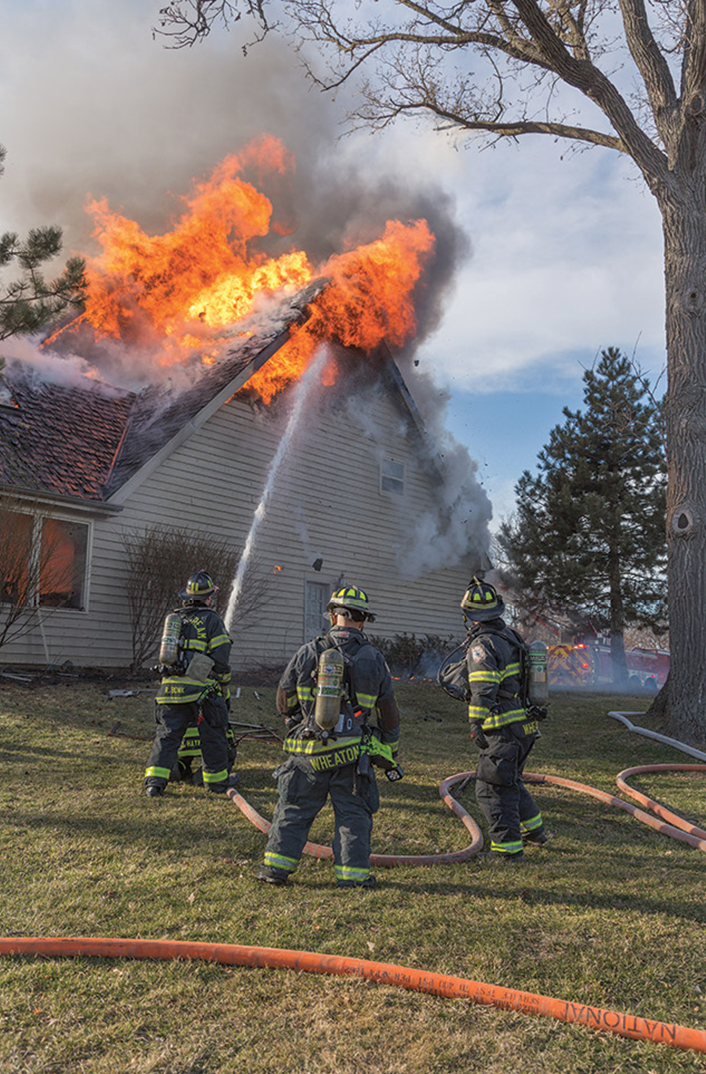
(1) Firefighters from Carol Stream (IL) Fire Department Engine 29 and Wheaton Tower 38 stretch and operate a second line in sector B of a well-involved house fire. (Photos by John Tulipano.)
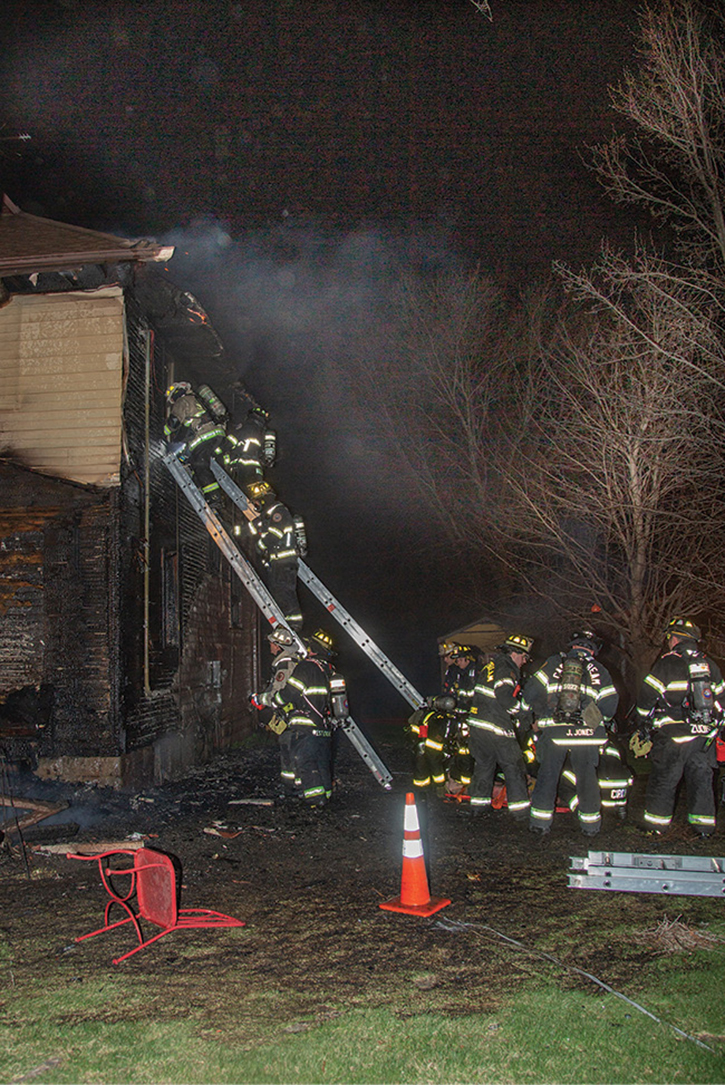
(2) Members from the Carol Stream, Wheaton, and Winfield (IL) Fire Departments attempt entry into the second floor to search for two trapped civilians; a 94-year-old civilian was rescued from this window but succumbed to injuries a few days later.

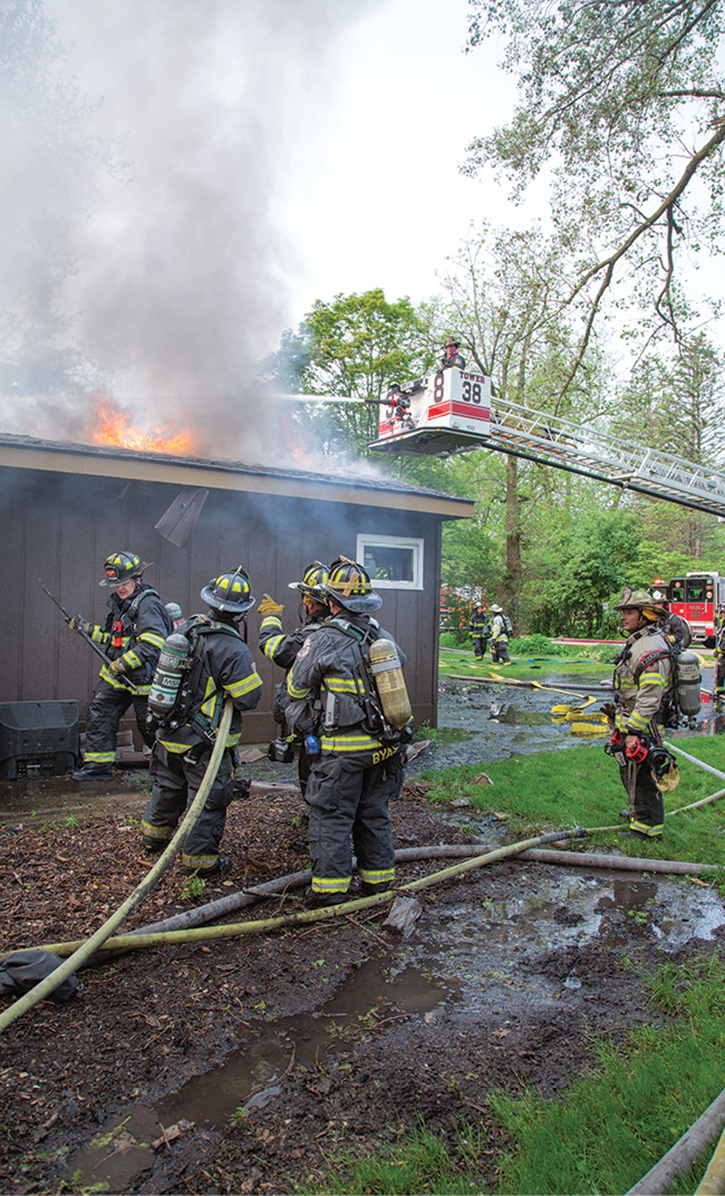
(3) Bloomingdale (IL) Fire Department Tower Ladder (TL) 23 Firefighter Dave Kaczkos overhauls the exterior soffit while members of TL 38 continue with master stream operations. (4) Members of Wheaton Engine 39 move a handline into position for wash down. Battalion Chief Jeff Buccola (Battalion 6) is sector officer, and TL 38 continues master stream operations. Carol Stream Squad 27’s crew awaits orders to start interior overhaul.

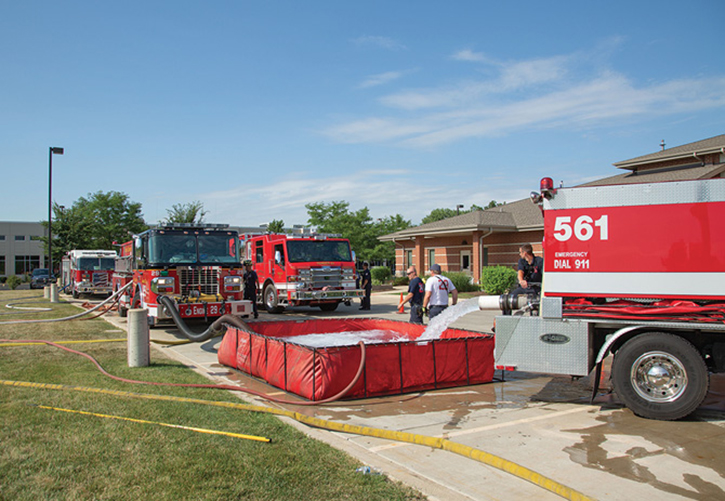
(5) In an Alliance monthly company operations drill, members from Bloomingdale, Carol Steam, West Chicago, and Roselle participate in a multicompany drill at a vacant school slated for demolition. (6) An Alliance monthly operations drill for tender operations and water supply.
The sharing of training facilities and instructors among all Alliance departments has not only improved training at the two training facilities but also reduced costs. Standard operating guidelines have been developed for all departments, and even the layout and storage of tools and hose on apparatus have been standardized so a member of one department knows where to find a tool on another department’s rig.
Of all the common goals developed and met, improved response is critical. The nearest unit responds regardless of municipality. Even more important is the “beefing up” of the initial response to a reported structural fire to three engines, three trucks, a squad, three medic units, and five chiefs including three battalion chiefs and two chiefs or deputy chiefs from member departments. Increasing the size of the response on the initial alarm has had a very beneficial effect on the outcome. The incident commanders know who they are getting on the initial response, and the companies themselves have preplanned duties.
Although there is automatic response in some large metropolitan departments, it is rare for a small group of communities to band together for the greater benefit of all. The Alliance has had great success because all the members benefit and want it to work.
Second Fire
At the same time the first call was received, the second 911 center receives the call, using its CAD system to run through common questions and identify incident type. The dispatcher continues to take call information and completes the call before setting off each station’s tones. Each is repeated and is eight seconds in duration, total. Tone alerting, alone, takes about 30 to 45 seconds to complete before call information is relayed. The closest three stations are alerted for the structure fire and will bring only what they decide to or typically do for similar responses. As the response commences, the first-due station responds with an engine and a rescue squad. The second and third stations respond with an engine. Three engines and one rescue squad are now responding to the structure fire.
As the first engine arrives on scene, members decide they want to forward lay a 900-foot supply line from the closest hydrant to the scene and rely on the hydrant’s residual pressure alone to overcome the friction loss. They lay out and begin to pull lines and go inside, with their rescue squad acting as the RIT. The second engine arrives and pulls up right to the scene. The fire is building, and the pump on the first engine is screaming. Water is getting on the fire but not enough.
The second engine’s crew notices residents in the second-story window. They get a 24-foot ladder off their truck, but because the second story is farther from the ground in the rear (because of a basement) where the residents are, they are forced to attempt to work through the second story from the front of the house to make rescues. The hallway is now charged with smoke upstairs, with heat building.
The third engine arrives on scene and pulls a line off the first engine, going inside to assist the first engine in knocking down the fire. Command makes the decision to request additional resources, asking dispatch to tone out the next two stations on the run card and “find a truck company.” Because there are missing automatic-aid agreements, members of the station that should be second due to the call are still asleep in their beds, only seven minutes away from the incident; the ladder truck and engine sit in the bay, unavailable for the call. The next two stations are 15 and 20 minutes away, respectively.
The next two stations are dispatched and the latter, 20 minutes away, is asked over the radio for their truck company to respond after the dispatch. The fire is quickly growing out of control. Flames are climbing the stairwell, as no ventilation has occurred to allow heat to escape; a second line is just now being put into service. The rescue efforts on the second floor are difficult, with the fire now impinging on the Division 2 crew’s only escape route. The pump on the first engine is starting to have trouble because of the long layout and distance from the driveway to the house.
Command decides to evacuate the building. The residents are pulled out unconscious with major burns to the face and shoulder after being carried through the superheated gases in the hall. The operation is now in defensive mode. The fourth engine and aerial device arrive and set up for defensive operations. The house is a near total loss.
Need a System
You can question tactics and dispatch policies, but the most important realization is that the second fire lacked a resource-based emergency response system. Although many consider all-hazards response to mean we must spec engines to respond to everything and limit the need for specialized units, this definition is not what all-hazards response as an emergency response system should be. All-hazards response for an emergency means having all the tools you need for a given incident type to accomplish all scene tasks at least until a second alarm can arrive, if necessary.
In a resource-based emergency response system, each unit has its place and is expected to accomplish a certain set of tasks. Yes, modifications to this initial incident action plan set by standard procedure can be done and should be based on availability of crews and tasks that need to be accomplished. However, without ensuring specialized units are identified and responding when they could likely be needed, mitigation efforts are sure to be fruitless. “But, what about the times we don’t need them?” you might ask. It’s much easier to turn units around that are a few minutes or even seconds away than get units on the road and to the scene that are 20 minutes away.
We are providing a service. To effectively provide that service, emergency response must be an integrated system that eliminates classic mutual aid and builds an automatic-aid system that incorporates every agency with firefighting resources so that they can be dispatched and assigned quickly and specifically based on the needs of the incident and distance to the call, regardless of the jurisdiction or imaginary political boundaries. Consider that each jurisdiction’s fire protection service is only a piece of the emergency response system; also consider the needs of its area as well as the needs of neighboring jurisdictions.
When an incident commander notices that the fire is building in the structure and a truck company that is needed for ventilation isn’t on the road, the fire is already a loss. Different units have different roles and can provide specific equipment. That is the reason National Fire Protection Association 1901, Standard for Automotive Fire Apparatus, exists and makes requirements for ladders and other equipment or water capacity to be carried based on unit type.
Without a resource-based emergency response system, there is no telling what units will show up to the scene and no telling what equipment will be available. Time is of the essence, whether for a trauma patient trapped in a vehicle with 30 minutes left in her “Golden Hour” or for a structure fire progressing quickly and threatening the lives of the residents trapped upstairs. Assignments of today must include resource specification (or unit dispatching) to ensure all the equipment, personnel, and water get to the scene that could likely be needed for the first initial actions, best allowing for the preservation of life, property, and the environment.
Editor’s note: This article is written by the author and does not express the views of the United States Air Force.
Nathan S. Lindgren is a fire officer/lead firefighter with the United States Air Force stationed at Joint Base San Antonio, Texas. He started with the Bay District (MD) Volunteer Fire Department in 2012, joining the Air Force three years later as a firefighter and working his way up over five years as an engineer and a company officer. He has been stationed in Germany and Texas. Since he joined the Air Force, he has received a bachelor of applied science in emergency management and an associate of arts in homeland security from Waldorf University, along with an associate of science in fire science from the Community College of the Air Force.
Robert S. Hoff recently retired as chief of the Carol Stream (IL) Fire Protection District after a 47-year career in the fire service including 35-plus years in the Chicago (IL) Fire Department (CFD), where he rose to the rank of commissioner. He was the recipient of the CFD’s highest award for bravery, the Lambert Tree Award, twice for the rescue of civilians at fires. He left Chicago in 2012 and joined Carol Stream and was appointed chief in 2016. Hoff is an instructor for the Illinois Fire Service Institute.

